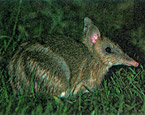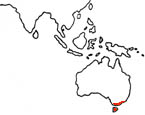|
Eastern
Barred
Bandicoot
(Perameles gunnii) |
||||
|
|
Physical
characteristics and distribution
|
|
Head
and body length is 200-425 mm and tail length of 75-170 mm.
Weights are 450-900 grams. Coloration is drab brown, dull
orange, grayish brown or gray with interspersed black-tipped
hairs. Diagonal dark and light bars occur on the rump, sometimes
forming and elaborate pattern. Underparts are white or whitish.
The snout is long and tapered and the large ears are pointed.
Perameles gunnii inhabits woodlands and open country with good ground cover. Nests are oval mounds of twigs, leaves, and humus on the surface of the ground or in more open areas, excavated chambers or abandoned rabbit burrows, hollow logs, or rock piles. Eastern Barred Bandicoots are nocturnal, terrestrial and extremely active. They
are primarily insectivorous, but also eat a variety of worms,
lizards, snails, mice and plant materials. They are found in Australia: S Victoria, where restricted to Hamilton and Tasmania.
|
|
Description
of the brain
|
|
The brain weight is 5.313 g (includes R. Trg. & C2 + C3 DRG). The brain meaurements are: Length AP left 20.1 mm; Length AP right 19.5 mm; Bitemporal width 23.5 mm; Temporal height left 15.8 mm; Temporal height right 16.1 mm. |
|
Animal
source and preparation
|
|
All
specimens collected followed the same preparation
and histological procedure.
|
Other Related Resources (websites and publications)



